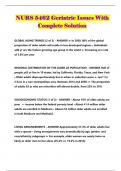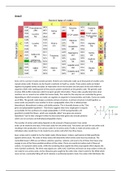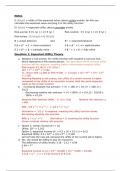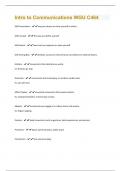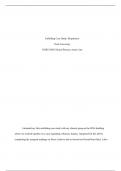EMERGING COMMUNICATION TECHNOLOGIES
What is emerging communication technology?
• Emerging = coming into existence
• Technology = something that is build and not part of the natural environment
• Communication = for the purpose of communicating through OR with
People have always been interacting with emerging communication technology.
Some similarities across emerging technology
• It always starts with an innovation
• That can take quite a long time to evolve
• There are profound diEerences in adoption
• It doesn’t always last…
• It comes with the good and the bad
Each emerging communication technology started with a technological
development.
1. DIFFUSION & ACCEPTANCE OF TECHNOLOGY
What happens when technologies arrive in society? How do they get adopted? Who
adopts them?
MODELS ON COMMUNICATION TECHNOLOGY DIFFUSION
DIFFUSION OF ONLINE TECHNOLOGY
Journalism = the gathering, assessment, creation, and
presentation of news and information.
How to obtain that information? Prior to the WWW: specific
client-based services, such as Lexis-Nexis and CompuServe.
History of Technology – Internet
1969: ARPANET (Advanced Research Projects Agency
Network) = Birth of the internet
1993: Mosaic browser
= First graphical browser
= First ‘killer app’ (= app that demonstrates value of tech to
a large population)
Main RQ of article: Who are the adopters of WWW for obtaining information (who are
the first people to use internet for obtaining information)? ® Journalists. When the
internet arrived in society, the practice of journalism changed.
1
, The online tools and technologies available for
journalists to obtain information.
The internet more than tripled over five years. The
bulletin boards that they used prior to the internet
decreased from one third to one fifth in five years.
The amount of internet information that specific
people look for: primarily the reporters became
interested in using the internet for information.
The reporters are adopters, the non-reporters are
non-adopters.
Di:usion conclusions
• Technology adoption: WWW as a search tool in the newsroom
• Substitution of previous technology: older client-based services
• Identification of important groups: users percentages changed more in specific
groups than they do in other groups (journalist as adopters and librarians and
editors as non-adopters).
DIFFUSION OF INNOVATIONS (DOI)
E.g. The emergence of the telephone
• What communication technology did the telephone substitute? The telegram (we
went from text to speech).
• What are the positive things of the telephone? Hearing actual voices, human
speech, and more humanlike connection.
• Who were the first users (early adopters)? Businesspeople, doctors (to be able to
be called into work), wealthy people (to show oP) etc. So not everybody used it.
Terminology
• DiEusion = the social process by which an innovation is communicated through
certain channels over time among the members of a social system.
• Innovation = an idea, practice, or object that is perceived as new by an individual
or other unit of adoption (so it’s about perceptions, the user needs to perceive
something as innovative).
• Channels = two distinct ways (1) Mass Media and (2) Interpersonal
Communication.
• Social System = group of interrelated agents (work, family, etc.).
• Adoption can mean two things
o Substitution of previous technology with new technology (e.g. journalists
and WWW, morse code vs. telephone (19th century)).
o New technology, without substitution of previous technology.
2
,Three general variables that a:ect di:usion
1. Attributes/characteristics of the innovation: pros & cons
Innovations possess certain characteristics which, as perceived by adopters,
determine the ultimate rate and pattern of adoption. So, they are all about
perceptions and not about the technological innovation itself.
a. Costs: how many resources should I invest to use it?
b. EPectiveness: is it better than what it replaces?
c. Simplicity/complexity: how easy is it to use?
d. Compatibility: does it fit with what I already do? Or do I have to change my
entire life or organization just to use this technology?
e. Observability: can I ‘see’ the outcomes of using it? (e.g. work faster?)
f. Trialability: can I go back to the previous technology?
2. Attributes/characteristics of the adopters: social influences
There are five diEerent adopter groups, defined by how early or how fast they
adopt an innovation. Some potential adopters are more prone to innovate than
others and can be identified as such by their personal characteristics (education,
age, job tenure etc.). Adopters can be usefully classified according to where they
adopt relative to others:
a. Innovators
• The first to try out technologies they perceive as new
• Risk-takers in terms of usefulness of the technology
• Unconstrained by social norms
• Very limited eEort needed from marketing etc.
b. Early adopters
• Tend to be opinion leaders; they get diEusion going
• Feel the need to change old technologies and adopt new
technologies
• Already convinced of the usefulness of the new technology
c. Early majority
• Stronger need evidence that the new technology is useful
• Social pressure, norms: tend to follow opinion leaders, but are
not an opinion leader
d. Late majority
• Tend to be skeptical towards change, need more convincing of
the usefulness
• Social influences: will only adopt after the majority has tried it / is
using it
e. Laggards
• Tend to be even more skeptical towards change
• Hardest group to get onboard
• Unconstrained by social norms (unaEected in the opposite way
from innovators)
3
, Typical diEusion pattern: the process starts
out slowly among pioneering adopters,
reaches “take-oE” as a growing community
of adopters is established and the eEects of
peer influence arise, and levels-oE as the
population of potential adopters becomes
exhausted thus leading to an “S-shaped”
cumulative adoption curve.
• To promote widespread dissemination of an innovation, each adopter group
should be targeted using diEerent communication channels & messages (each
adopter group has diEerent perceptions thus needs a diEerent persuasion).
• Opinion leaders and change agents: the actions of these certain individuals can
accelerate diEusion, especially when potential adopters view such individuals as
being similar to themselves.
• So, in the first groups: identify change agents to obtain critical mass (= a self-
sustaining rate of adoption when a suEicient number of users has been reached)
because the rate of adoption increases when critical mass has been achieved.
• THE INNOVATION-DECISION PROCESS
Adoption decision stages: the adoption decision unfolds as a series of stages,
flowing from knowledge of the innovation through persuasion, decision,
implementation, and confirmation. Adopters are predisposed towards diEerent
kinds of influence (e.g. mass-market communication vs. word-of-mouth) at
diEerent stages.
1. Knowledge: when an individual becomes aware that the innovation exists
& starts to understand how it works (example: ChatGPT).
2. Persuasion: when an individual develops a positive opinion towards the
innovation.
3. Decision: when aware & with a positive opinion, an individual will - at some
point - try out the innovation.
4. Implementation: application of the innovation in one’s daily life, with
increasing levels of usability and easy-of-use.
5. Confirmation: continued levels of innovation use and confirmation biased
information seeking.
3. Attributes of the broader context: social & political influences
® The digital divide, there are elements in society that make some people lag in
society (people in the digital divide are not purposeful laggards).
MODELS ON COMMUNICATIONS TECHNOLOGY ACCEPTANCE
TECHNOLOGY ACCEPTANCE MODEL (TAM)
Details: How do people make that decision?
4
,Developed in business administration research, but applicable in any domain.
Four key variables
1. Perceived usefulness of that technology: degree to which the technology is
perceived as improving life / work / etc. (e.g. social media for 24/7 contact,
chatbot for buying tickets instead of travel agent, self-parking cars, self-
checkout in supermarket without remembering pin code).
2. Perceived ease-of-use of that technology: using the technology is easy and free
from any eEort. EEort is a finite resource, so allocating it to eEortless activities
(mental and physical) will be preferred.
3. Attitude towards that technology: summary of thoughts (usefulness and ease-
of-use) towards the technology. Favorable attitude summarizes favorable
perceptions of usefulness and/or ease-of-use.
4. Intention to adopt technology: cognitive representation of willingness to act (®
trial attempt or repeated actions).
® Actual use: single / occasional / habitual use of technology.
5
, UNIFIED THEORY OF ACCEPTANCE & USE OF TECHNOLOGY (UTAUT)
Adoption of the Technology Acceptance Model
Integration of 8 (!) theories
• Theories from behavioral models (TRA, TPB, MM, SCT)
• Theories from technology diEusion (DOI)
• Theories from technology acceptance (TAM, MPCU)
• Theories from combinations (C-TPB-TAM)
UTAUT does not want to predict outcomes diEerent from TAM, UTAUT want to predict
outcomes better than TAM.
Four factors influence
intention
General assumption
UTAUT: more PE, and/or
more EE, and/or more SI,
and/or more FC, then
stronger intention!
• Performance Expectancy (PE) = same as ‘Perceived Usefulness’
• EEort Expectancy (EE) = same as ‘Ease-of-Use’
• Social Influence (SI) = perception of an individual about his/her social
environment: what do important others think that I should do?
• Facilitating Conditions (FC) = perception of an individual about his/her physical
environment: does an (organization/technical) infrastructure exists that
facilitates behaviour? E.g. there are parts of the world that are deprived of the
internet, so they have poor facilitating conditions.
Meta-analysis = statistical method to
summarize (in numbers) a systematic literature
review.
• Summarize what? Associations between UTAUT variables
• Summarize why?
o Scientific reasons: inconclusive results to date on the UTAUT model.
o Practical reasons: what to do if we want to promote technology
acceptance?
6
, • Systematic literature review
o Keywords: ‘UTAUT’; ‘user acceptance’; ‘technology adoption’
o Nine diEerent databases
• 197 articles retrieved
• Based on inclusion & exclusion criteria: 74 articles retained
PE-BI: Association between Perceived E6icacy & Behavioral Intention
EE-BI: Association between E6ort Expectancy & Behavioral Intention
SI-BI: Association between Social Influence & Behavioral Intention
FC-BI: Association between Facilitating Conditions & Behavioral Intention
BI-USE: Association between Behavioral Intention & Technology Use
FC-USE: Association between Facilitating Conditions & Technology Use
All associations are positive and
significant: UTAUT is validated.
Some associations are more
positive than others: input for
technology acceptance promotion.
If you want to increase technology use: increase behavioral intention (BI) or facilitating
conditions (FC) (0.49 > 0.38). If you want to increase behavioral intention: increase either
performance ePiciency (PE) or facilitating conditions (both associations are 0.55).
NEGATIVE CONSEQUENCES OF DIFFUSION: DIGITAL DIVIDE
Digital Divide?
• Old definition: the distinction between users and non-users of (new)
communication technology.
• New definition: not being able to have access to, and/or knowledge on how to live
in the digital age. This became quite visible during the pandemic where a lot of
people were homeschooled and didn’t have access to the internet.
The digital divide is circular: no access to technology ® worse education ® lower
socio-economic situation ® no access to technology ® …
7
, ADOPTION GROUPS – INTERNET AND MOBILE PHONES
Who are the non-users of (new) technology?
From WWW to mobile internet use
Data from nationally representative survey in USA on mobile phone internet use
No diEerence in gender
Low income ® less likely to adopt
Low education ® more likely to non-adopt
Migrant background ® less likely to adopt
ADOPTION GROUPS – WALKING APPS
Research Question: Can TAM-variables help us understand relationship
Socio-Economic Status & technology use? Can TAM help us understand
digital divide better?
• Technology use: walking apps on mobile phones
• Participants: 1219 Dutch adults
• Large 5-year study (4000k EUR): SupremeNudge
o Development of app lasted > 2 years
o Available for Android & iOS
• Socio-Economic Status
o Income categories: low, middle, high
o Education (highest obtained): low, middle, high
TAM
• Usefulness of walking app
o Useful for me to keep track of my walking behavior
o Helpful for me to go walking every day
• Ease-of-Use: the way the user environment on the app works, is
o Easy for me to learn
o Clear for me to understand
Higher income? 28% more likely to use app
Higher education? 40% more likely to use app
8
What is emerging communication technology?
• Emerging = coming into existence
• Technology = something that is build and not part of the natural environment
• Communication = for the purpose of communicating through OR with
People have always been interacting with emerging communication technology.
Some similarities across emerging technology
• It always starts with an innovation
• That can take quite a long time to evolve
• There are profound diEerences in adoption
• It doesn’t always last…
• It comes with the good and the bad
Each emerging communication technology started with a technological
development.
1. DIFFUSION & ACCEPTANCE OF TECHNOLOGY
What happens when technologies arrive in society? How do they get adopted? Who
adopts them?
MODELS ON COMMUNICATION TECHNOLOGY DIFFUSION
DIFFUSION OF ONLINE TECHNOLOGY
Journalism = the gathering, assessment, creation, and
presentation of news and information.
How to obtain that information? Prior to the WWW: specific
client-based services, such as Lexis-Nexis and CompuServe.
History of Technology – Internet
1969: ARPANET (Advanced Research Projects Agency
Network) = Birth of the internet
1993: Mosaic browser
= First graphical browser
= First ‘killer app’ (= app that demonstrates value of tech to
a large population)
Main RQ of article: Who are the adopters of WWW for obtaining information (who are
the first people to use internet for obtaining information)? ® Journalists. When the
internet arrived in society, the practice of journalism changed.
1
, The online tools and technologies available for
journalists to obtain information.
The internet more than tripled over five years. The
bulletin boards that they used prior to the internet
decreased from one third to one fifth in five years.
The amount of internet information that specific
people look for: primarily the reporters became
interested in using the internet for information.
The reporters are adopters, the non-reporters are
non-adopters.
Di:usion conclusions
• Technology adoption: WWW as a search tool in the newsroom
• Substitution of previous technology: older client-based services
• Identification of important groups: users percentages changed more in specific
groups than they do in other groups (journalist as adopters and librarians and
editors as non-adopters).
DIFFUSION OF INNOVATIONS (DOI)
E.g. The emergence of the telephone
• What communication technology did the telephone substitute? The telegram (we
went from text to speech).
• What are the positive things of the telephone? Hearing actual voices, human
speech, and more humanlike connection.
• Who were the first users (early adopters)? Businesspeople, doctors (to be able to
be called into work), wealthy people (to show oP) etc. So not everybody used it.
Terminology
• DiEusion = the social process by which an innovation is communicated through
certain channels over time among the members of a social system.
• Innovation = an idea, practice, or object that is perceived as new by an individual
or other unit of adoption (so it’s about perceptions, the user needs to perceive
something as innovative).
• Channels = two distinct ways (1) Mass Media and (2) Interpersonal
Communication.
• Social System = group of interrelated agents (work, family, etc.).
• Adoption can mean two things
o Substitution of previous technology with new technology (e.g. journalists
and WWW, morse code vs. telephone (19th century)).
o New technology, without substitution of previous technology.
2
,Three general variables that a:ect di:usion
1. Attributes/characteristics of the innovation: pros & cons
Innovations possess certain characteristics which, as perceived by adopters,
determine the ultimate rate and pattern of adoption. So, they are all about
perceptions and not about the technological innovation itself.
a. Costs: how many resources should I invest to use it?
b. EPectiveness: is it better than what it replaces?
c. Simplicity/complexity: how easy is it to use?
d. Compatibility: does it fit with what I already do? Or do I have to change my
entire life or organization just to use this technology?
e. Observability: can I ‘see’ the outcomes of using it? (e.g. work faster?)
f. Trialability: can I go back to the previous technology?
2. Attributes/characteristics of the adopters: social influences
There are five diEerent adopter groups, defined by how early or how fast they
adopt an innovation. Some potential adopters are more prone to innovate than
others and can be identified as such by their personal characteristics (education,
age, job tenure etc.). Adopters can be usefully classified according to where they
adopt relative to others:
a. Innovators
• The first to try out technologies they perceive as new
• Risk-takers in terms of usefulness of the technology
• Unconstrained by social norms
• Very limited eEort needed from marketing etc.
b. Early adopters
• Tend to be opinion leaders; they get diEusion going
• Feel the need to change old technologies and adopt new
technologies
• Already convinced of the usefulness of the new technology
c. Early majority
• Stronger need evidence that the new technology is useful
• Social pressure, norms: tend to follow opinion leaders, but are
not an opinion leader
d. Late majority
• Tend to be skeptical towards change, need more convincing of
the usefulness
• Social influences: will only adopt after the majority has tried it / is
using it
e. Laggards
• Tend to be even more skeptical towards change
• Hardest group to get onboard
• Unconstrained by social norms (unaEected in the opposite way
from innovators)
3
, Typical diEusion pattern: the process starts
out slowly among pioneering adopters,
reaches “take-oE” as a growing community
of adopters is established and the eEects of
peer influence arise, and levels-oE as the
population of potential adopters becomes
exhausted thus leading to an “S-shaped”
cumulative adoption curve.
• To promote widespread dissemination of an innovation, each adopter group
should be targeted using diEerent communication channels & messages (each
adopter group has diEerent perceptions thus needs a diEerent persuasion).
• Opinion leaders and change agents: the actions of these certain individuals can
accelerate diEusion, especially when potential adopters view such individuals as
being similar to themselves.
• So, in the first groups: identify change agents to obtain critical mass (= a self-
sustaining rate of adoption when a suEicient number of users has been reached)
because the rate of adoption increases when critical mass has been achieved.
• THE INNOVATION-DECISION PROCESS
Adoption decision stages: the adoption decision unfolds as a series of stages,
flowing from knowledge of the innovation through persuasion, decision,
implementation, and confirmation. Adopters are predisposed towards diEerent
kinds of influence (e.g. mass-market communication vs. word-of-mouth) at
diEerent stages.
1. Knowledge: when an individual becomes aware that the innovation exists
& starts to understand how it works (example: ChatGPT).
2. Persuasion: when an individual develops a positive opinion towards the
innovation.
3. Decision: when aware & with a positive opinion, an individual will - at some
point - try out the innovation.
4. Implementation: application of the innovation in one’s daily life, with
increasing levels of usability and easy-of-use.
5. Confirmation: continued levels of innovation use and confirmation biased
information seeking.
3. Attributes of the broader context: social & political influences
® The digital divide, there are elements in society that make some people lag in
society (people in the digital divide are not purposeful laggards).
MODELS ON COMMUNICATIONS TECHNOLOGY ACCEPTANCE
TECHNOLOGY ACCEPTANCE MODEL (TAM)
Details: How do people make that decision?
4
,Developed in business administration research, but applicable in any domain.
Four key variables
1. Perceived usefulness of that technology: degree to which the technology is
perceived as improving life / work / etc. (e.g. social media for 24/7 contact,
chatbot for buying tickets instead of travel agent, self-parking cars, self-
checkout in supermarket without remembering pin code).
2. Perceived ease-of-use of that technology: using the technology is easy and free
from any eEort. EEort is a finite resource, so allocating it to eEortless activities
(mental and physical) will be preferred.
3. Attitude towards that technology: summary of thoughts (usefulness and ease-
of-use) towards the technology. Favorable attitude summarizes favorable
perceptions of usefulness and/or ease-of-use.
4. Intention to adopt technology: cognitive representation of willingness to act (®
trial attempt or repeated actions).
® Actual use: single / occasional / habitual use of technology.
5
, UNIFIED THEORY OF ACCEPTANCE & USE OF TECHNOLOGY (UTAUT)
Adoption of the Technology Acceptance Model
Integration of 8 (!) theories
• Theories from behavioral models (TRA, TPB, MM, SCT)
• Theories from technology diEusion (DOI)
• Theories from technology acceptance (TAM, MPCU)
• Theories from combinations (C-TPB-TAM)
UTAUT does not want to predict outcomes diEerent from TAM, UTAUT want to predict
outcomes better than TAM.
Four factors influence
intention
General assumption
UTAUT: more PE, and/or
more EE, and/or more SI,
and/or more FC, then
stronger intention!
• Performance Expectancy (PE) = same as ‘Perceived Usefulness’
• EEort Expectancy (EE) = same as ‘Ease-of-Use’
• Social Influence (SI) = perception of an individual about his/her social
environment: what do important others think that I should do?
• Facilitating Conditions (FC) = perception of an individual about his/her physical
environment: does an (organization/technical) infrastructure exists that
facilitates behaviour? E.g. there are parts of the world that are deprived of the
internet, so they have poor facilitating conditions.
Meta-analysis = statistical method to
summarize (in numbers) a systematic literature
review.
• Summarize what? Associations between UTAUT variables
• Summarize why?
o Scientific reasons: inconclusive results to date on the UTAUT model.
o Practical reasons: what to do if we want to promote technology
acceptance?
6
, • Systematic literature review
o Keywords: ‘UTAUT’; ‘user acceptance’; ‘technology adoption’
o Nine diEerent databases
• 197 articles retrieved
• Based on inclusion & exclusion criteria: 74 articles retained
PE-BI: Association between Perceived E6icacy & Behavioral Intention
EE-BI: Association between E6ort Expectancy & Behavioral Intention
SI-BI: Association between Social Influence & Behavioral Intention
FC-BI: Association between Facilitating Conditions & Behavioral Intention
BI-USE: Association between Behavioral Intention & Technology Use
FC-USE: Association between Facilitating Conditions & Technology Use
All associations are positive and
significant: UTAUT is validated.
Some associations are more
positive than others: input for
technology acceptance promotion.
If you want to increase technology use: increase behavioral intention (BI) or facilitating
conditions (FC) (0.49 > 0.38). If you want to increase behavioral intention: increase either
performance ePiciency (PE) or facilitating conditions (both associations are 0.55).
NEGATIVE CONSEQUENCES OF DIFFUSION: DIGITAL DIVIDE
Digital Divide?
• Old definition: the distinction between users and non-users of (new)
communication technology.
• New definition: not being able to have access to, and/or knowledge on how to live
in the digital age. This became quite visible during the pandemic where a lot of
people were homeschooled and didn’t have access to the internet.
The digital divide is circular: no access to technology ® worse education ® lower
socio-economic situation ® no access to technology ® …
7
, ADOPTION GROUPS – INTERNET AND MOBILE PHONES
Who are the non-users of (new) technology?
From WWW to mobile internet use
Data from nationally representative survey in USA on mobile phone internet use
No diEerence in gender
Low income ® less likely to adopt
Low education ® more likely to non-adopt
Migrant background ® less likely to adopt
ADOPTION GROUPS – WALKING APPS
Research Question: Can TAM-variables help us understand relationship
Socio-Economic Status & technology use? Can TAM help us understand
digital divide better?
• Technology use: walking apps on mobile phones
• Participants: 1219 Dutch adults
• Large 5-year study (4000k EUR): SupremeNudge
o Development of app lasted > 2 years
o Available for Android & iOS
• Socio-Economic Status
o Income categories: low, middle, high
o Education (highest obtained): low, middle, high
TAM
• Usefulness of walking app
o Useful for me to keep track of my walking behavior
o Helpful for me to go walking every day
• Ease-of-Use: the way the user environment on the app works, is
o Easy for me to learn
o Clear for me to understand
Higher income? 28% more likely to use app
Higher education? 40% more likely to use app
8


